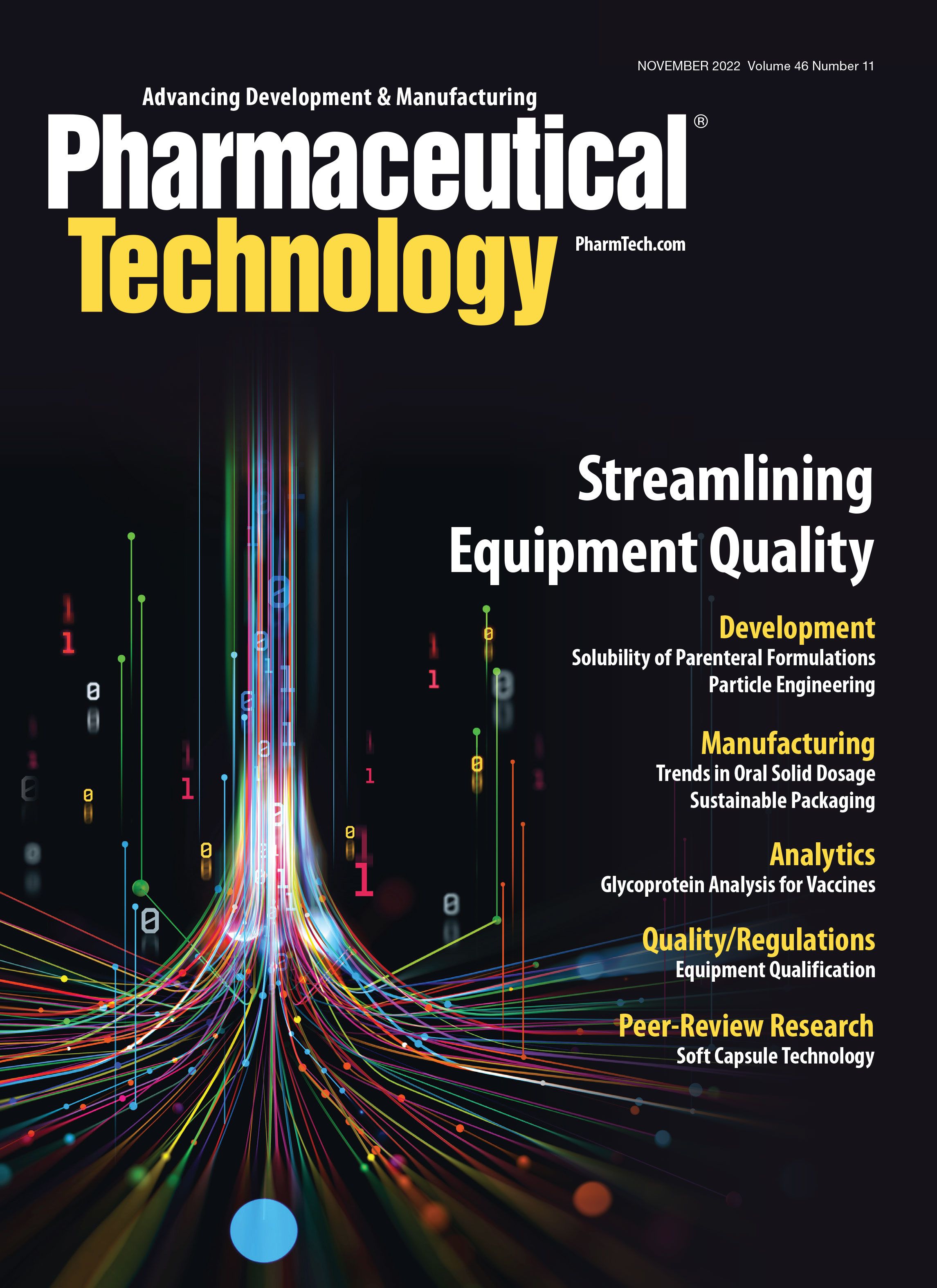Examining Trends in Oral Solid Dosage Manufacturing
The state of oral solid dose manufacturing is influenced by new approaches, novel technologies, and the structural evolution of the raw materials market.
AJISAI13 - STOCK.ADOBE.COM

When one thinks of medicine, the first image that comes to mind will likely be a small white pill, or perhaps an orange bottle full of them. While biologic therapies and various parenterals have experienced significant advances in recent years, the ubiquity of oral solid dosage (OSD) drugs —whether pills, tablets, capsules, soft gels, effervescence, gummies, or any other variant— remains at the forefront of the industry.
“OSD drug delivery systems are predominantly preferred over a parenteral (injection or drip) intravenous drug delivery for many reasons,” says Paul DiMarco, vice-president of Global Commercial Operations, BioSpectra. “Not the least of which being ease of use, lower purity demands due to the acidic environment of the stomach, and little or no medical supervision during administration.”
The popularity of OSD puts it at the heart of the pharmaceutical industry, and it is particularly susceptible to emerging trends or market forces. This article examines the latest technologies and trends unique to OSD, as well as takes a look at the greater market forces influencing its production.
Embracing new approaches
One process that the pharmaceutical industry as a whole has been attempting to adopt, where possible, is continuous manufacturing, due to the decreased resource drain and increased flexibility continuous processes provide. However, while continuous manufacturing has seen steady growth, OSD has faced some difficulties in switching over due to the nature of its manufacturing process—the first oral solid dosage drug manufactured via a continuous approach was not approved until 2015 (1). Largely, these difficulties resulted from the equipment being designed with downtime in mind.
In this regard, various equipment suppliers have stepped in to try to ease continuous manufacturing hiccups. For instance, L.B. Bohle’s QbCon1, a continuous dryer and granulator, uses a novel process to allow for infinite operation without needing to stop the machine for cleaning (2). Similarly, Herma US released modules for its 132M HC Wrap-around Labeler that allow for it to be integrated into a continuous manufacturing process without needing downtime for replacement paper (3). In this vein, companies have come to the understanding that facilities must be designed with continuous “powder-to-tablet” capabilities in mind.
On the client end, there has also been increased demand for other new approaches, as Robert Sedlock, director at Natoli Scientific, notes.
“In the past few years there has been a push for collecting data in a more scientific approach. USP [United States Pharmacopeia] published a new chapter (4) concerning tablet characterization methods, which require instrumented tablet presses,” says Sedlock. “There is now a higher demand for instrumented single-station machines, rotary tablet presses, and compaction emulators/simulators. Understanding material mechanical properties is now a standard in the OSD industry.”
This standard is a natural evolution of the current pharmaceutical industry: as data integration becomes more pronounced, client companies are going to want more detailed information to refine their processes. Savvy manufacturers will build and design processes with this in mind as a means of satisfying ever-increasing data demands, which will in turn continually influence the technologies and approaches of OSD manufacturing.
Examining materials sourcing
A striking dichotomy has emerged in sourcing for the two components of oral solid dosage drugs, excipients and APIs. Excipients are typically considered more complex than APIs, largely as a result of their multi-component nature. This characteristic often results in the performance impact of the various components being not well understood; in a similar vein, the composition profiles of complex mixtures may not be well-defined. In contrast, APIs are comparatively simple mixtures—they are improved by reducing the presence of all other chemicals, which can render them inert or result in unintended side effects (5).
However, the stark difference in relative complexity has shaped who is producing them. Because excipients are relatively complex formulations, they require significant regulatory oversight to ensure consumer safety. Consequently, they are largely manufactured in countries with well-regarded, overarching regulations; North America holds the largest share in the pharmaceutical excipient market, followed by Europe (6).
“Pharmaceutical companies in the United States and Europe are held to a rightful standard by [FDA]—one that is not equally experienced by their counterparts in China and India,” says DiMarco. “These companies use higher purity ingredients and fine chemicals sourced from local manufacturers and, consequently, produce higher quality [and] more consistent, more sophisticated finished drug products.”
APIs, on the other hand, do not need to be quite as closely scrutinized, allowing countries like India and China, who have less stringent regulations and much lower labor costs, to leverage those characteristics to gain a manufacturing stranglehold. While it should be noted that there is some dispute over the precise numbers, in particular because most drug manufacturers do not need to disclose where they source APIs, in 2017 the United Kingdom’s Medicines and Healthcare products Regulatory Agency (MHRA) estimated that 40% of global API production was coming from China at the time of the report (7). Similarly, a 2021 report from Mordor Intelligence, a marketing intelligence firm, indicated that approximately 75% to 80% of APIs imported to the US were coming from China or India at the time of their report (8).
This dichotomy in materials sourcing has shaped the landscape of the oral solid dosage manufacturing industry. For instance, while there have been calls to reshore production following the supply chain interruptions brought on by the COVID-19 pandemic, the reliance of the US on these countries for API sourcing complicates that matter; it is particularly exacerbated by desires to reduce drug costs, which necessitates outsourcing to countries who can price relative to their labor costs.
“The supply chain security issues that began with tariff wars between China and the US, followed by the pandemic, continue through this day with strained supply chain logistics and raw material capacity constraints,” says DiMarco. “The worsening relationship between the US and China could quickly lead to more serious conflict and could easily become an existential event that would dwarf in comparison all previous challenges regarding supply chain issues and constraints.”
References
1. Vertex Pharmaceuticals, “FDA Approves Orkambi,” Press Release, July 2, 2015.
2. L.B. Bohle, “Continuous Granulation and Drying for the Pharmaceutical Industry QbCon 1 – R&D,” www.lbbohle.com, accessed Oct. 28, 2022.
3. Freudenberg Medical, “Freudenberg Medical Launches HeliFlex TPE Tubing at Bioprocess International Conference,” Press Release, Sept. 29, 2022.
4. USP, “General Chapter <1062> Tablet Compression Characterization,” USP 36–NF 31 (Rockville, MD, Dec. 1, 2017).
5. B. Carlin, et al., Pharmaceutical Technology 46 (8) 2022.
6. IPEC Federation, Qualification of Excipients for Use in Pharmaceuticals (IPEC, Brusells, 2nd ed., 2020).
7. MHRA, Medicines and Healthcare products Regulatory Agency International Strategy, www.gov.uk (2017).
8. Mordor Intelligence, Active Pharmaceutical Ingredients (API) Market-Growth, Trends, COVID-19 and Forecasts, (2022 - 2027), Market Research Report, 2021.
About the author
Grant Playter is the Assistant Editor for Pharmaceutical Technology, BioPharm International, and Pharmaceutical Technology Europe.
Article details
Pharmaceutical Technology
Vol. 46, No. 10
October 2022
Pages: 26-27
Citation
When referring to this article, please cite it as G. Playter, "Examining Trends in Oral Solid Dosage Manufacturing," Pharmaceutical Technology 46 (11) 26-27 (2022).

Drug Solutions Podcast: A Closer Look at mRNA in Oncology and Vaccines
April 30th 2024In this episode fo the Drug Solutions Podcast, etherna’s vice-president of Technology and Innovation, Stefaan De Koker, discusses the merits and challenges of using mRNA as the foundation for therapeutics in oncology as well as for vaccines.